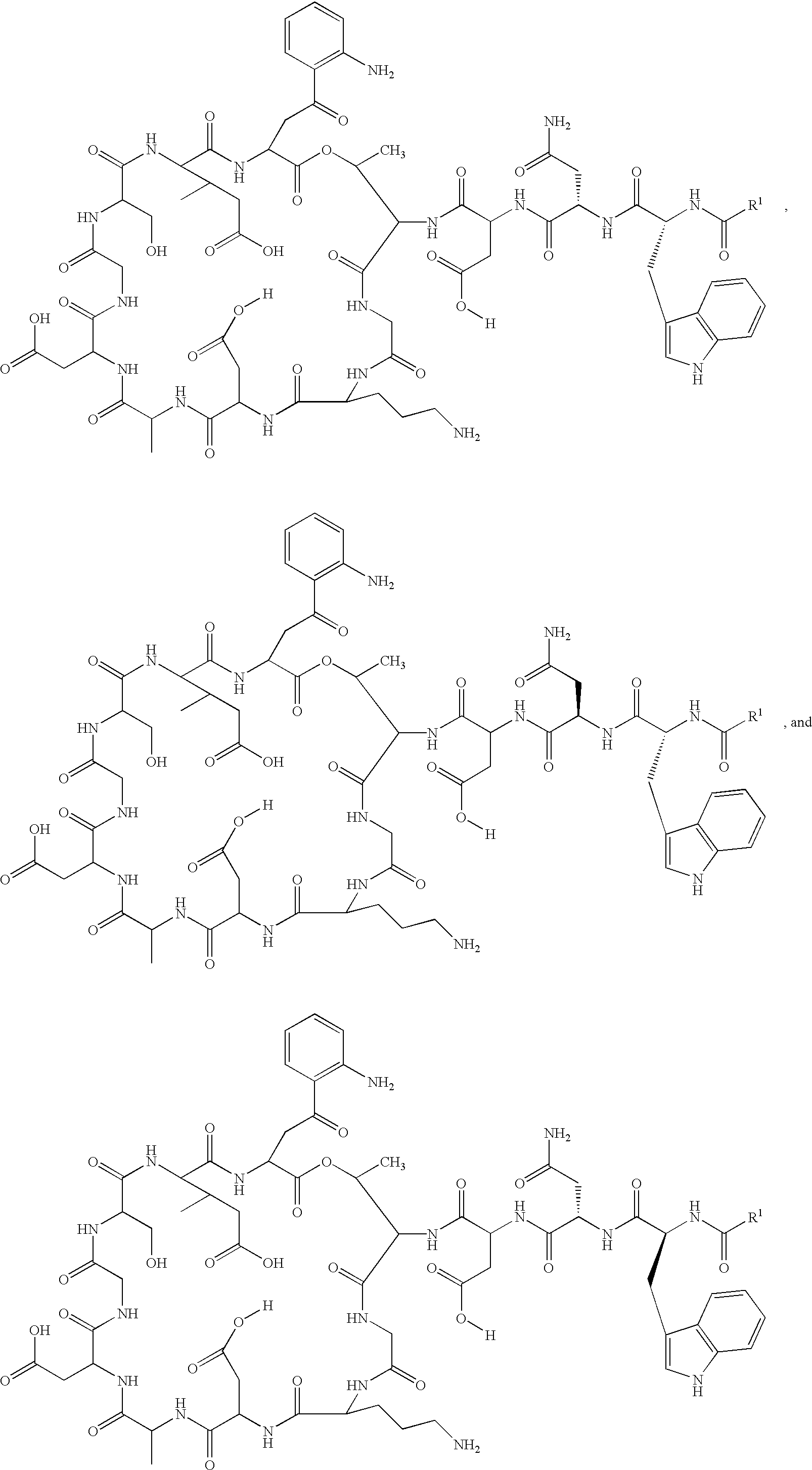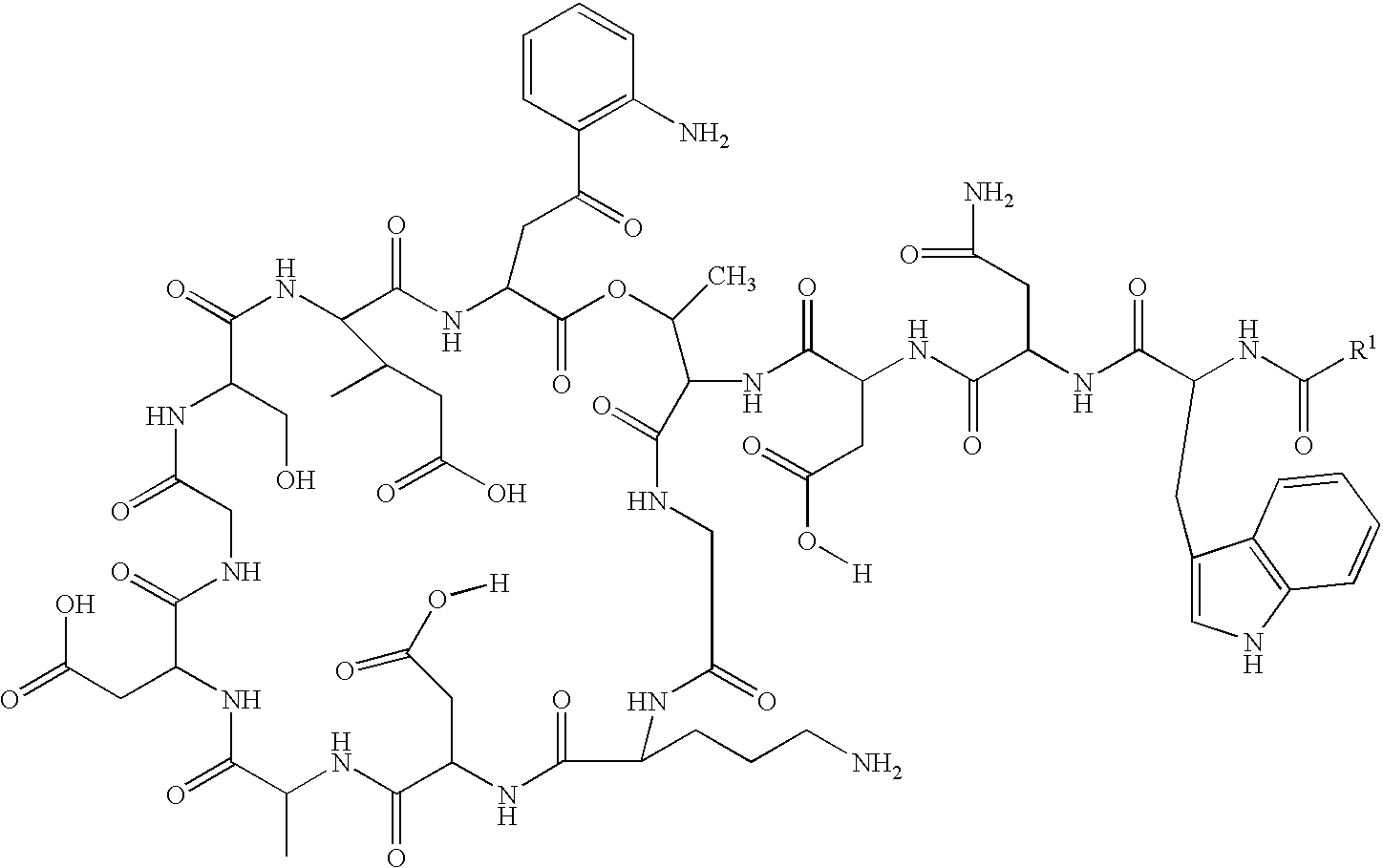Lipopeptide stereoisomers, methods for preparing same, and useful intermediates
a technology of lipopeptides and stereoisomoeric compounds, which is applied in the field of process for preparing daptomycin and novel daptomycin stereoisomoeric compounds, can solve the problems of virtually untreatable life-threatening infections
- Summary
- Abstract
- Description
- Claims
- Application Information
AI Technical Summary
Benefits of technology
Problems solved by technology
Method used
Image
Examples
example 1
Synthesis of Compound E
[0221]
[0222]To a solution of commercially available L-tryptophan-t-butyl ester hydrochloride (3.07 g), decanoic acid (3.19 g) and diisopropylethylamine (12.3 ml) in dry tetrahydrofuran (100 ml) was added 1-(3-dimethylaminopropyl)-3-ethylcarbodiimide hydrochloride (2.92 g). The reaction mixture was stirred at room temperature for 18 hours before partitioning between 1 M hydrochloric acid (150 ml) and ethyl acetate (150 ml). The organic layer was washed with saturated sodium chloride (150 ml), dried with anhydrous sodium sulfate and evaporated to dryness to give compound A (6 g).
[0223]
[0224]Compound A (6 g) and ethanedithiol (200 μl) were stirred in 25% trifluoroacetic acid in dry dichloromethane (60 ml) at room temperature for 4 hours. The solvent was evaporated and the residue was purified on silica gel using ethyl acetate as eluent to give compound B as an oil (5 g).
[0225]
[0226]To a solution of compound B (1.13 g), L-asparagine-4-nitrobenzyl ester hydrobromid...
example 2
Synthesis of Compound L
[0231]
[0232]To a stirred solution of commercially available N-Boc-D-Asparagine (4 g), 4-nitrobenzyl alcohol (2.9 g) and triphenylphosphine (6.77 g) in dry tetrahydrofuran (200 ml) was added diisopropylazodicarboxylate (3.81 g) at room temperature. The reaction mixture was stirred for 24 hours. The mixture was diluted with ethyl acetate (100 ml), washed with water (50 ml) and saturated sodium chloride (50 ml). The organic layer was dried over anhydrous sodium sulfate and evaporated to dryness. The residue was triturated with diethylether (50 ml) to give compound F as a white solid (4.3 g).
[0233]
[0234]Compound F (2 g) and 1,2-ethanedithiol (0.2 ml) were stirred in trifluoroacetic acid (2 ml) and dry dichloromethane (8 ml) at room temperature for 4 hours before being evaporated to dryness. The residue was purified by silica gel chromatography eluting with 15% methanol / dichloromethane to give the compound G as a white solid (1.2 g).
[0235]
[0236]To a stirred solutio...
example 3
Synthesis of Compound R
[0245]
General Procedure A Coupling of an Acid to a Resin.
[0246]A 0.5 M solution of the acid (2 ml) was added to 0.2 mmol of resin. To this mixture a 0.5 M solution of 1-hydroxybenzotriazole (2 ml), and a 0.5 M solution of 1,3-diisopropylcarbodiimide (2 ml) were added and the mixture was shaken for 90 mins at room temperature. The resin was then filtered and washed with 1-methyl-2-pyrrolidinone (3×6 ml), methanol (3×6 ml), and 1 -methyl-2-pyrrolidinone (3×6 ml). Reaction completion was determined by a negative (yellow) Kaiser test. If the test remained positive the coupling procedure was repeated until negative.
General Procedure B Fmoc deprotection on a resin.
[0247]The resin (0.2 mmol) was shaken with 20% piperidine in 1 -methyl-2-pyrrolidinone (6 ml) for 5 mins. The resin was filtered and shaken with 20% piperidine in 1-methyl-2-pyrrolidinone (6 ml) for 40 mins. The resin was then filtered and washed with 1-methyl-2-pyrrolidinone (3×6 ml), methanol (3×6 ml), a...
PUM
 Login to View More
Login to View More Abstract
Description
Claims
Application Information
 Login to View More
Login to View More - R&D
- Intellectual Property
- Life Sciences
- Materials
- Tech Scout
- Unparalleled Data Quality
- Higher Quality Content
- 60% Fewer Hallucinations
Browse by: Latest US Patents, China's latest patents, Technical Efficacy Thesaurus, Application Domain, Technology Topic, Popular Technical Reports.
© 2025 PatSnap. All rights reserved.Legal|Privacy policy|Modern Slavery Act Transparency Statement|Sitemap|About US| Contact US: help@patsnap.com



